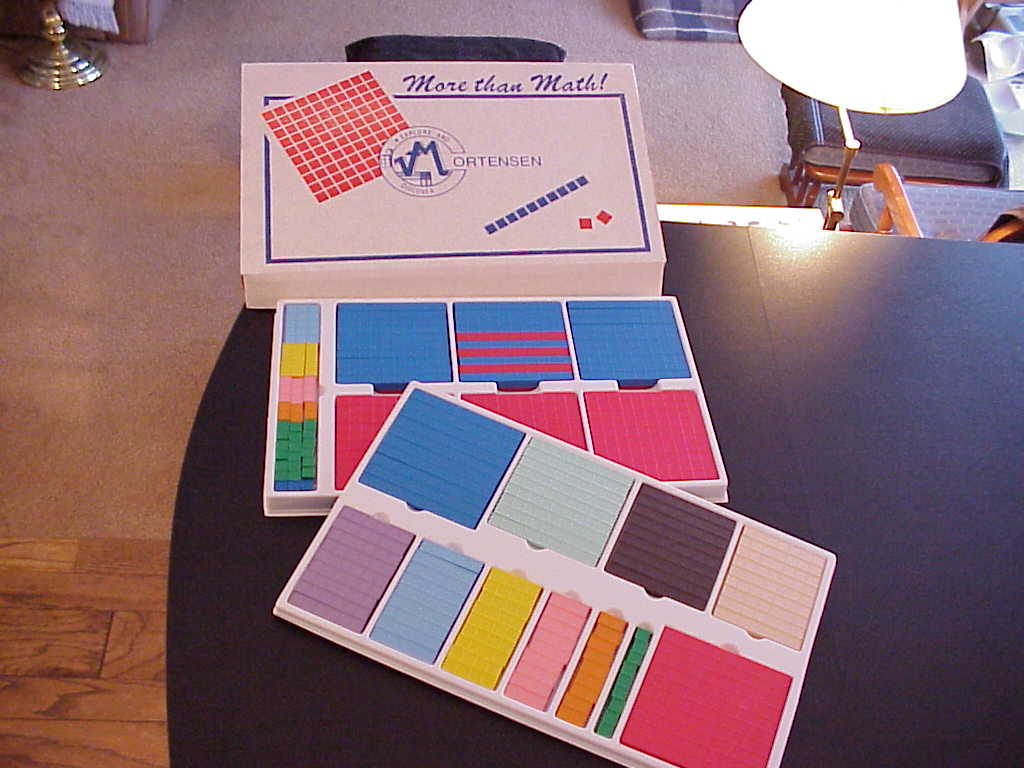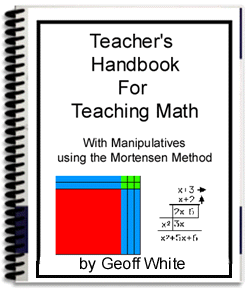Teaching Math With Manipulatives
| Purchasing Dilemmas | Products/Price List | Comparing Methods | Understanding | Mental Images | A Fractions Example | Psychological Principles at Work | Self-Esteem - Teacher's Role | Acquiring Meaning | A Philosophy of Teaching Math | A Math-Rich Environment | Main Page

Purchasing dilemmasGeoff White, B.Ed. (Southampton, UK) * Available for seminars / workshops / Pro-D days Many schools and or home schoolers encounter dilemmas for various reasons when considering adopting a new math program. Here is some actual correspondence between a math co-ordinator and myself regarding this topic: Nicole wrote: Hi Geoff, We have had many positive discussions regarding your pro-d here. We are still sorting through many of the details. I think we need to sit down and talk so that I can tell you exactly what we are thinking. We are excited about adopting a new program. Working through the logistics is what takes the time. One of our main concerns is how to fully implement it from grades K-6/7. Would we do it in stages or jump in for the whole primary? Somehow we need to talk a little more. I have already talked to one home school mom who was keenly interested so keep thinking about tapping into the home school market here. Hope this communication is a beginning of much more to come. Nicole Dear Nicole, Thanks for the update, glad to know you're thinking of me. Grades 6-8 are not too late in a student's math education to introduce a new approach but there is no doubt a budget concern here. I would suggest for the 6-8 phase that you continue to use the materials you have, but I know those teachers, having seen my method will employ some of the model in areas where they think they can achieve an impact on the learners. This will not require any further expenditure as they have already learned the method from me. Having a copy of my Teacher's Handbook will make it easier for them though. Grades 4-5 can use Mortensen Exercise books alongside their existing texts(?) with no conflict. We have found this helps a lot with success rates, self-image, motivation, as well as math scores. This means only a minimal cost for exercise books in the appropriate topics as decided by the teacher. You have base ten blocks for those classes already. Here the teacher may rely more heavily on drawing examples, once having introduced the topic with the manipulatives. Again this suggestion is with minimum expenditure in mind. K-3 is the area I would suggest adopting the method completely, subject to individual teacher's desires. I wouldn't want to force a new method on anyone, especially when they are already stressed by enough prep work. I'm sure some of them may think using MM would be an additional burden. My experience is that it is less prep work - because the exercise books allow the children to get on with it without having any immediate prodding from the teacher. Some of the class inevitably likes the attention of being led by the hand and told step by step to do this, wait, turn the page, wait, etc. but this is something we trained them to do and we can un-train them. The children will proceed through the ex. books on their own impetus once they discover that it is fun and something they can do. We use a chart to track progress through the books. It is a useful incentive tool. You can purchase the ex. books as you go, so no budget money need be tied up in books sitting on shelves before they are needed. An order should only take a week or two to be received, maybe less. Consider this: Suppose you have 100 children in K-3. Start with 3 books each, all in arithmetic. For the more advanced children it will be easy, while they are learning to use the rectangular model doing easy examples. (The books do not say Grade one, two, three on them.) You may even persuade the older ones to draw the examples from the books onto paper rather than to work in the book itself? This might save a few bucks and enable you to stretch the budget. or, you could buy 35 sets of Arithmetic books. Have the Grade ones work in the first 3 books; the grade twos start with book 4; the grade threes start with book 7. The program is not set out with that precision, but you would be able to swap books until you find a level of challenge with the brighter children and can accommodate the less advanced ones too. The teacher will meanwhile be teaching the method of 1. See all numbers as rectangles. 2. build rectangles to make the counting easier. 3. all operations are just building rectangles. then they will merrily continue on in the exercise books wherever they happen to be. You have sets of examples on worksheets or we have the source books as I showed you that can be employed to keep them busy. At the minimum to do this a teacher needs: my Teacher's Handbook, some manipulatives of at least the base ten blocks you already have, and some photocopied worksheets of examples. Any extra money then can be applied to: exercise books, or buying additional manipulatives. Most important is training the teachers on the method, and this you ahve already done. The more they use it the better things will get. The teachers, having had my workshop will need time to synthesize the method. This is best done by teaching it. If they choose to do it gradually, that's OK. Soon they will know where they want more clarity, be it in themselves or in the students' materials: books or blocks. 1. Plastic Blocks. Your school has suitable manipulatives now. Obviously this can be improved, but it is not the priority at this time - assuming a limited budget. If you had lots of funds, then it's easy - buy it all, but that may not be practicable right now. 2. teacher's manuals My Teacher's Handbook is a necessity. For this to work, teacher understanding is vital. If the teacher is not comfortable with the method and convinced that it is the right thing to do, a change in programs is unlikely to work. You get a VHS tape of my seminar along with the Handbook remember. 3. Ex. books Having a complete set for reference so that the instructor can see where it is going and to assess where a student should start or progress is very useful. I'm talking about the first three levels (that's roughly K-9) in three strands minimum: Arithmetic, Measurement, Problem solving. In this way the teacher can pick out a particular topic, say, fractions multiplication, for a lesson. Or provide remedial material for a student as necessary. That's 90 books to be kept as a teacher's resource. This is an absolute minimal way to get started as it applies to your school. Anything above this, is of course, better. You may choose for budgetary reasons to leave the algebra strand for later, OK. But levels 1-3 of the calculus are excellent for improving multiplication facts and for problem solving even in the early grades. The way level one is set out it is all about multiplication facts/skills.
If a complete set is on hand for reference, then additional ex. books for use without drawing in them is next. Then, having an ex. book for each child to actually work in and take home when complete is best. Schools can purchase ex. books individually. Best price is a minimum order of 300 books. This overview should help you to make a plan. sincerely, Geoff White By 1998 the demand on my schedule had become so heavy I knew had to find another way to reach more people. My solution was to record my workshop on video. I willingly send the tapes to interested parties I couldn't teach in person. The problem with that scheduling solution was no one could ask questions. Extra explanations were missing because I wasn't there in person at the white board. That led me to the development of a Teacher's Handbook. I'll tell you more about that in a minute. You probably want to know more about the Mortensen Math system first. MORTENSON MORE THAN MATH employs manipulatives to enhance the child's ability to visualize math concepts, to decode the mathematical language into spatial reality. The best way I know to explain the Mortensen Math system is to talk about memory first. How good is your short-term memory? More importantly, how good is your short-term memory with numbers? Suppose I gave you 12 numbers, each of them seven digits long. Do you think you could remember them for an hour? Five minutes? Do you think you could remember them long enough to write them down, even right after I told you? Not likely. That's because you've been taught like everyone else to memorize the hard way. The hard way is how most students are taught math as well. The truth is the entire math curriculum used in traditional teaching situations, employing textbooks, relies on memorizing nothing but FACTS, RULES, FORMULAE AND PROCESS! Our job as educators is to decode this mathematical language of symbols into a concrete reality. This is what the method does. |
Teacher's Handbook for Teaching Math with Manipulatives- In use in schools and homes around the world: Canada, USA, UK, Eire, Holland, Belgium, Australia, New Zealand, Papua & New Guinea, Philippines, Taiwan, Malaysia, Singapore, Indonesia, Thailand, SW Africa, Mexico, to name a few where I have placed it personally.
Table of Contents The Premise The Five-Minute Overview of the Method Key Phrases in Mortensen Math Very Brief Summary of the Method Psychological Principles at Work Introduction - cont'd Create a Math-Rich Environment The Teacher's Role & Student Self-Esteem Six Key Ideas from Jerry Mortensen Appendices: Section One - Counting Section Two - Addition Section Three - Subtraction Section Four - Multiplication Section Five - Division Section Six - Fractions Section Seven - Algebra Section Eight - Solving Equations Section Nine - Functions & Relations Section Ten - Story Problems Section Eleven - Mortensen Math Program NOW in .PDF format! No postage costs, instant delivery! The Teacher's handbook, 250 pages, full color, $65 USD
To order: send payment by Paypal to me at
Want to read more about Mortensen Math?Read all about Mortensen Math here:
|
Below: A Combo Kit - 2 trays in one box, enough for 6 students to work from at once.


